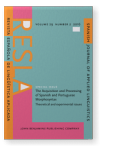Comparing anaphora resolution in early and late Brazilian Portuguese-European Portuguese bidialectal bilinguals
The present study examines anaphora resolution in two groups of speakers exposed to Brazilian and European Portuguese (BP and EP, respectively), considering the different null subject distribution in these languages. Our research question is whether late BP-EP bilinguals (age of EP onset: 29.1) and heritage BP speakers raised in Portugal (age of EP onset 5.6), tested in both dialects, will pattern like the native controls or display some effects of EP in their native BP or vice-versa. This is an interesting question in light of the Interface Hypothesis, which claims that external interfaces should be subject to general bilingualism effects irrespective of language pairing and age (Sorace, 2011). The results show that age has an effect, as the heritage speakers do not perform like the late learners, and that the high degree of typological proximity between the two languages could hinder bidialectal acquisition.
